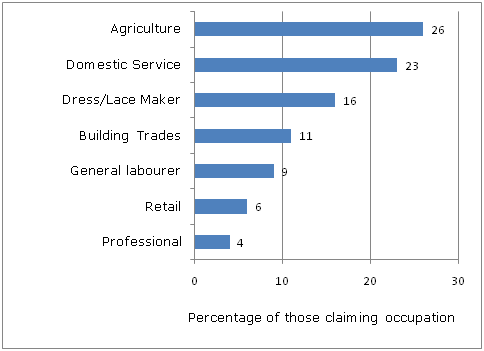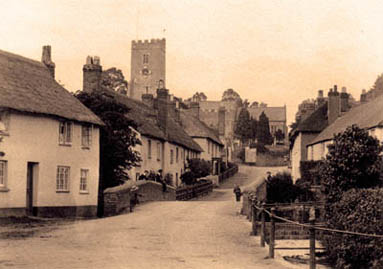Ovapedia search :
Title:
Until 1894 the historic parish of East Budleigh included all the land running south towards the sea and, therefore, the emerging town of Budleigh Salterton. The census returns for 1891, and all earlier ones, include the populations of both East Budleigh and Budleigh Salterton, even though the latter had had the larger share of the total population since the early part of the nineteenth century. Having looked at the descriptions for the boundaries in an earlier article concerned with the Budleigh Salterton population (1) it seemed reasonable and unambiguous, to assume Budleigh Salterton is defined by the boundaries of enumeration districts 1 and 2, and East Budleigh by enumeration districts 3 and 4. For consistency this definition has been maintained in this article. Included in East Budleigh are: Tidwell, a small fringe of Knowle including Knowle House and Leeford House, Dalditch and Ting Tong.
The following analysis is taken from detailed study of the facsimiles of the 1891 census returns available for downloading and printing (2).
In total there were 200 houses (4 unoccupied) with 868 inhabitants at the time of the census of whom 2 were visitors, leaving 866 permanent inhabitants recorded. The visitors were two teenage girls possibly visiting relatives.
Sixty-one (7% of the permanent population) described themselves as retired or living on independent means or were obviously part of the household where the head was so described. This is half the figure for Budleigh Salterton and much more in line with the age distribution where 8% of the population was aged sixty-five or more. Of these twenty were born in Devon (48%), showing that the retirees to East Budleigh had a much stronger Devon connection than those retiring to Budleigh Salterton. As with Budleigh Salterton a high proportion of the remaining population were born in Devon (699 or 87%).
Three hundred and fifty-six (44% of the non retired population) claimed some form of occupation. Forty women claimed to be seamstresses or dress makers and seventeen claimed to be lace makers (nearly twice the number of lacemakers compared to Salterton). There was one lace dealer: Robert Bucknell (64), a widower whose three daughters were dressmakers. The demise of the “Honiton” lace trade followed by a short resurgence around Queen Victoria’s wedding up to the Great Exhibition is summarised by Hoskins (3) and sufficiently noteworthy as to form part of the analysis at (4). The waning influence of Lace schools accelerated by the Education Act of 1870 is also summarised in the OVApedia article on early schooling in East Budleigh (5). George Honey was the master of the National School and his tenure of the post, including the sacking of his predecessor and his own “difficult” nature, is documented in the same article.
The occupation or “calling” data for 1891 are known, nationally, to be weak. One can only conjecture as to the degree of economic activity implied by this high level of claimed occupation since very few marked the “employed” or “employee” boxes, which had been introduced in an attempt to improve occupational data collection. Some returns, therefore, may reflect aspiration rather actual employment. There was, however, only one person described as a pauper. Three individuals were openly described as imbeciles.
Of those claiming an occupation 95% can be placed in one of the following seven groupings in descending order. These groupings were simply chosen on inspection to give a sense of proportion. They have been applied consistently although there are no nationally recognised definitions for the time. They should be regarded as indicative only.

These occupations and their relative magnitudes seem very much in keeping with a Devon farming community. They include: a Land Agent, Estate Clerk of Works (Robert Kingdon 39), Cattle Doctor, Land Drainer (William Holland 51), Miller (and Farmer), Forester, Saw Miller (Henry Bolt 40), Farrier, Assistant Gamekeeper, Wheelwrights (John Patet 39), Blacksmith (Mr Anniss 28), Shoe and General Smith (Charles Jewel 42), Carter (George Pile 49) and a Joly Driver (John Gooding 30); as well as farmers, poulterers, agricultural labourers and market gardeners. There is a post office (Post Master John Palmer 36) and grocers shop (Robert Pruddice 71), bakers (William Clotworthy 47, and Edward Cook 32), butcher (Robert Carter 45), shoemakers and coal merchant. There are two Public Houses or Inns: The Rolle Arms, George Pledger (60); and the King’s Arms, 26 High Street, John Shepherd (42) - but the only people staying in them as lodgers are two retired relatives of John Shepherd. Edward Moore (61), Barrister, also lodged in the town.

East Budleigh High Street c. 1900
Farms & Farmers
Church Farm – Eli Austin (54)
Hayes Farm – John Lawrence (61)
Hills Farm – Joseph Quick (44)
Nashmore Farm – John Quick (48)
Thorn Mill – John Hallett (39)
Tidwell Barton – William Lawrence (58)
Town Mills – Walter Tedbury (48)
49 Lower Budleigh – Samuel Pile (53)
Wynards Farm – William Carter (45) [who seemed to have one of the largest families in Budleigh – Wife, four sons and five daughters].
Plus two Farmers in Knowle: Mark Nicks (34) & Lewis Richards (46)
Note added by Roger Lendon regarding the lack of mention of Pulhayes farm in the 1891 census:
"The 1891 census is not very clear as Pulhays isn’t named, however, the farmer was Samuel Pile. He was the farmer in 1881 when it was annotated (as Pyle). Kelly’s Directory has him at Pulhays in 1893 and his probate record in 1908 describes him as “of Pulhayes Farm, East Budleigh”. So I think we can say he was there in 1891. They are in the census in 1891 at ? Tidwell Road."
Clergy & Ministers
The Vicar, William Green (53) lived in the vicarage with his wife, six daughters and one son, a governess, housemaid, cook and nurse. Robert Morrish (27) was gardener and sexton.
The East Budleigh Curate, Rev. C. Price (38) was living in Budleigh Salterton in Park House Lodge with his wife, daughter, three sons, a nurse, cook and housemaid.
There was also another “Clerk in Holy Orders” Philip Worlcombe, widower (69), living in Knowle House, Dalditch, which is on the edge of enumeration district 3, with a cook, parlour maid, general servant and coachman.
The Congregational Minister was James Phillip Murphy (37) living in 26 Lower Budleigh with his wife, son and daughter, a domestic help and an accountant lodger.
Leeford House (Knowle)
Leeford house was occupied by Lt. Col. (retired) Herbert Walker, Royal Artillery, his wife, two daughters and one son, a governess, cook, three housemaids and a lady’s maid.
Retirees included:
a surgeon, William Christopher (78); a school mistress, Victoria Taylor (58); two civil servants and two soldiers.
Researched and written by © David Daniel, 2009
This is the second of a short series of related articles comparing Budleigh Salterton and East Budleigh. It should not be regarded as complete. There may be more names that have relevance to those still living in the community that would be worth recording. The author would welcome feedback through the website, especially with regard to completeness and the spelling of names since the census is not easily legible.
References:
1. Budleigh Salterton Census 1891. A snapshot of the population. The people and their occupations. BS-G-00007
2. Ancestry.co.uk
3. Devon by W G Hoskins, David & Charles 1978 ISBN 0 7153 5577 5
4. www.visionofbritain.org.uk Statistical summary of the population 1891.
5. Early Schooling in East Budleigh OVApedia EB-G-00004
74 EB-G-00006 any
